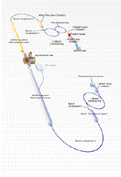|
|
|
Electron-Positron Linear Collider
- The JLC Project -

Schematic View of the JLC
|
The JLC project consists of the construction of an electron-positron linear collider and the experiment therewith, at a start up center of mass energy of around 250 GeV. The accelerator will eventually reach TeV energy region, along with successive machine upgrades. The JLC machine will allow us to study elementary processes that could have happened only in the early very hot universe and will pave a way to uncover the secrets of the creation and evolution of our universe.
The JLC project stems from the Japanese High Energy Committee's recommendation made back in 1986 as the post-TRISTAN program for energy-frontier physics. Following the recommendation, we set up a 5-years R&D program to address key issues in basic component technologies and to formulate the project as a whole. The R&D program led us to the first project design in 1992, where we elucidated physics prospects and novel detector concepts matching the opportunities, and outlined the accelerator complex including its application to X-ray laser production.
The principal guideline shown there for the project promotion remains valid and even enforced especially in the necessity for further internationalization of the project. In this respect, the 1997 endorsement of the JLC as one of the major future facilities in the Asia-Pacific region is a remarkable milestone made by the Asian Committee for Future Accelerators (ACFA). This action in ACFA was an important step towards its realization in this region.
The inter-regional cooperation also became more important than ever, which is reflected in recent close cooperation with European and North American regions to promote R&D's for the linear collider.
In the first stage of an entire JLC program, we are planning to cover the center of mass energies of up to about 500 GeV with a luminosity of more than 1.5×1034 cm-2 sec-1.
A high luminosity e+e- collider of that class is capable of producing more than 0.5 million light Higgs bosons and top quarks within 5-6 years. Consequently, the facility naturally serves as a Higgs and top factory. In addition it has a remarkable physics potential as a W and Z factory equipped with highly polarized beams and a two-orders-of-magnitude higher luminosity than those of existing facilities.
|
|
